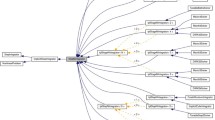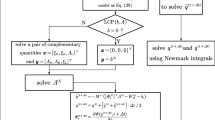Abstract
This paper proposes a non-iterative implicit integration method for real-time analysis of multibody systems. Although the implicit Euler integrator is widely used for real-time simulations, we use a HHT-α integrator to improve the accuracy of the solution. For a noniterative procedure, the HHT-α integral formula was reformed and applied to the linearized equations of motion for multibody systems. A stability analysis of the HHT-α integrator was carried out to determine whether the proposed integrator has absolute stability. Numerical simulations with stiff linear systems that represent a highly damped system and a highly oscillatory system were also carried out to evaluate the performance of the proposed integrator. For non-linear multibody systems, the performance of the proposed integrator was also evaluated with a double pendulum example. Through the double pendulum multibody simulations, we confirmed the accuracy and stability characteristics of the proposed integration method by comparison of the conventional HHT-α integrator with the iterative method and the implicit Euler integrator, which is widely used in real-time applications.
Similar content being viewed by others
References
A. Cardona and M. Geradin, Time integration of the equations of motion in mechanism analysis, Computers & Structures, 33 (3) (1989) 801–820.
E. J. Haug, D. Negrut and M. Iancu, A state-space-based implicit integration algorithm for differential-algebraic equations of multibody dynamics, Journal of Structural Mechanics, 25 (3) (1997) 311–334.
D. Negrut, R. Rampalli, G. Ottarsson and A. Sajdak, On an implementation of the Hilber-Hughes-Taylor method in the context of index 3 differential-algebraic equations of multibody dynamics (DETC2005–85096), Journal of Computational and Nonlinear Dynamics, 2 (1) (2007) 73–85.
D. Negrut, L. O. Jay and N. Khude, A discussion of loworder numerical integration formulas for rigid and flexible multibody dynamics, Journal of Computational and Nonlinear Dynamics, 4 (2) (2009) 021008.
J. Wang and Z. Li, Implementation of HHT algorithm for numerical integration of multibody dynamics with holonomic constraints, Nonlinear Dynamics, 80 (1–2) (2015) 871–825.
N. M. Newmark, A method of computation for structural dynamics, Journal of the Engineering Mechanics Division, 85 (3) (1959) 67–94.
H. M. Hilber, T. J. Hughes and R. L. Taylor, Improved numerical dissipation for time integration algorithms in structural dynamics, Earthquake Engineering & Structural Dynamics, 5 (3) (1977) 283–292.
G. Rill, A modified implicit Euler algorithm for solving vehicle dynamics equations, Multibody System Dynamics, 15 (1) (2006) 1–24.
B. Burgermeister, M. Arnold and B. Esterl, DAE time integration for real-time applications in multi-body dynamics, ZAMM-Journal of Applied Mathematics and Mechanics, 86 (10) (2006) 759–771.
M. Arnold, B. Burgermeister and A. Eichberge, Linearly implicit time integration methods in real-time applications: DAEs and stiff ODEs, Multibody System Dynamics, 17 (2–3) (2007) 99–117.
M. Carpinelli, M. Gubitosa, D. Mundo and W. Desmet, Automated independent coordinates’ switching for the solution of stiff DAEs with the linearly implicit Euler method, Multibody System Dynamics, 36 (1) (2016) 67–85.
M. Nakashima, Integration techniques for substructure pseudo-dynamic test, Proceedings of 4th U.S. National Conference on Earthquake Engineering, Palm Springs, California, USA (1990) 515–524.
D. Combescure and P. Pegon, a-Operator splitting time integration technique for pseudodynamic testing error propagation analysis, Soil Dynamics and Earthquake Engineering, 16 (7–8) (1997) 427–443.
A. Cunha, E. Caetano and P. Ribeiro, Non-iterative integration methods with desired numerical dissipation, Eurodyn 2014, Proceedings of the 9th International Conference on Structure Dynamics, Porto, Portugal (2014) 1819–1826.
K. E. Atkinson, An Introduction to Numerical Analysis, John Wiley & Sons, New York, USA (1978).
C. W. Gear, Numerical Initial Value Problems in Ordinary Differential Equations, Prentice-Hall PTR, Englewood Cliffs, USA (1971).
E. J. Haug, Computer Aided Kinematics and Dynamics of Mechanical Systems, Allyn and Bacon, Boston, USA (1989).
E. J. Haug, Intermediate Dynamics, Prentice Hall, Englewood Cliffs, USA (1992).
Author information
Authors and Affiliations
Corresponding author
Additional information
Recommended by Associate Editor Kyoung-Su Park
Myoungho Kim received his master’s degree in Mechatronics Engineering from Chungnam National University, Korea at 2013. He is currently studying Ph.D. at the Department of Mechatronics Engineering, Chungnam National University and the Korea Atomic Energy Research Institute. His research interests are multibody dynamics and control for robot systems.
Hajun Song graduated from the Dept. of Mechatronics Engineering at Chungnam National University, Korea in 2015. He received his master’s degree in Mechatronics Engineering from Chungnam National University in 2018. His research interests are real-time applications of multibody dynamics and modeling.
Sung-Soo Kim received his Ph.D. degree in Mechanical Engineering from University of Iowa, U.S.A., in 1988. He is currently a Professor of the Mechatronics Engineering Department at Chungnam National University, Daejeon, Korea. His research interests are real-time multibody dynamics and its application to automotive systems and robot systems.
Rights and permissions
About this article
Cite this article
Kim, M., Song, H. & Kim, SS. A non-iterative implicit integration method using a HHT-α integrator for real-time analysis of multibody systems. J Mech Sci Technol 33, 1087–1096 (2019). https://doi.org/10.1007/s12206-019-0208-2
Received:
Revised:
Accepted:
Published:
Issue Date:
DOI: https://doi.org/10.1007/s12206-019-0208-2




